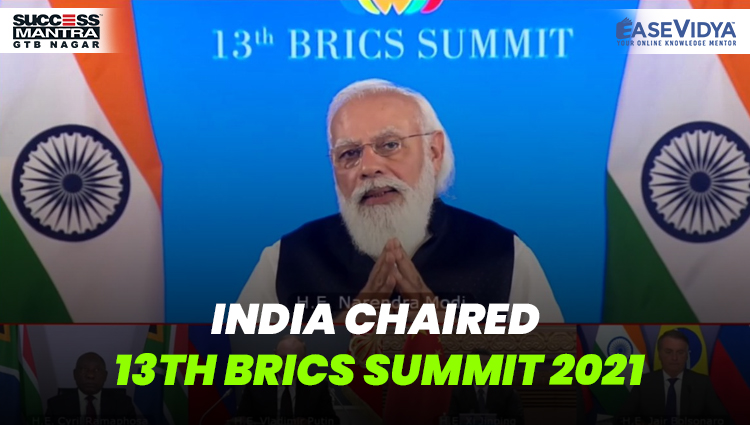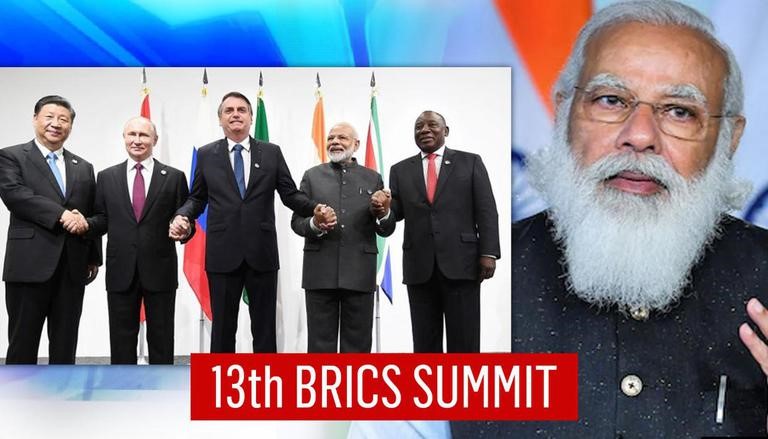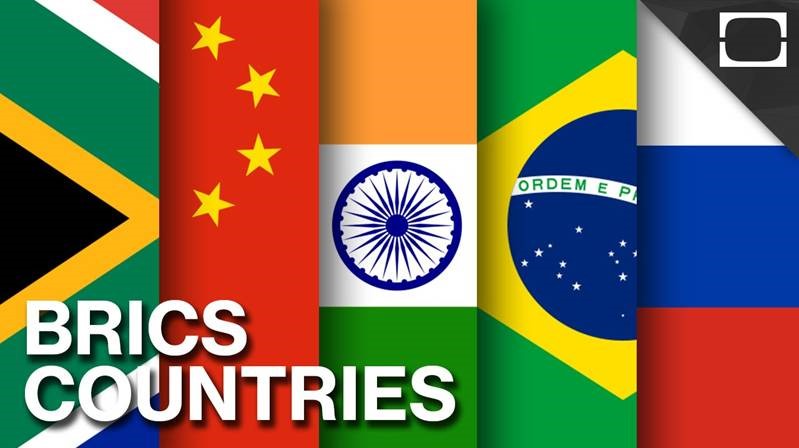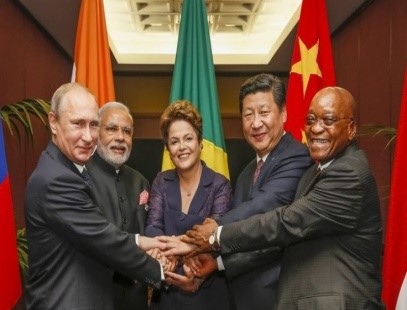
INDIA CHAIRED 13TH BRICS SUMMIT 2021
INDIA CHAIRED 13TH BRICS SUMMIT 2021

Recently, the Prime Minister chaired the annual summit of the BRICS which was held virtually. The theme for the Summit was 'BRICS@15: Intra-BRICS cooperation for continuity, consolidation and consensus'.
Current Affairs Notes By Success Mantra Coaching Institute GTB Nagar Delhi CLICK HERE
PM’s ADDRESS AT THE SUMMIT
- Highlighted the achievement of several new initiatives during India's Chairship this year (2021), i.e. an Agreement on cooperation in the field of remote-sensing satellites; a virtual BRICS vaccine Research & Development Centre; BRICS Alliance on Green Tourism, etc. Highlighting the leading role that BRICS countries can play in the post-Covid global recovery, Prime Minister called for enhanced BRICS cooperation under the motto of 'Build-back Resiliently, Innovatively, Credibly and Sustainably'.
- Adopted BRICS Counter Terrorism Action Plan: It defines the approach and actions of the BRICS countries towards areas of Counter Terrorism cooperation which includes: Countering Radicalization and Online Terrorist Threats, Border Management, Information/ Intelligence Sharing, etc.
- Adopted Delhi Declaration: The declaration called for reforms of the principal organs of the United Nations including that of the UN Security Council (UNSC). It is the first time that BRICS has taken a collective position on 'Strengthening and Reforming Multilateral Systems’. It also called for an “inclusive intra-Afghan dialogue” for stability in Afghanistan. Apart from Afghanistan, the BRICS leaders also took up the conflicts in Myanmar, Syria, the tension in the Korean peninsula, Israel-Palestine violence and other territorial disputes.
- On Covid-19: Noted the proposal made by India and South Africa at the World Trade Organisation (WTO) for the waiver of the Trade-Related Aspects of Intellectual Property Rights (TRIPS) mechanism to ensure a rapid expansion of the Covid-19 vaccine production around the world.
BRAZIL-RUSSIA-INDIA-CHINA-SOUTH AFRICA (BRICS)

- BRICS is an acronym for the grouping of the world’s leading emerging economies, namely Brazil, Russia, India, China and South Africa. The BRICS Leaders’ Summit is convened annually. BRICS does not exist in the form of organization, but it is an annual summit between the supreme leaders of five nations. The Chairmanship of the forum is rotated annually among the members, in accordance with the acronym B-R-I-C-S. BRICS cooperation in the past decade has expanded to include an annual programme of over 100 sectoral meetings.
- Together, BRICS accounts for about 40% of the world’s population and about 30% of the GDP (Gross Domestic Product), making it a critical economic engine. It’s an emerging investment market and global power bloc. The acronym "BRICS" was initially formulated in 2001 by economist Jim O'Neill, of Goldman Sachs, in a report on growth prospects for the economies of Brazil, Russia, India and China – which together represented a significant share of the world's production and population. In 2006, the four countries initiated a regular informal diplomatic coordination, with annual meetings of Foreign Ministers at the margins of the General Debate of the UN General Assembly (UNGA). This successful interaction led to the decision that the dialogue was to be carried out at the level of Heads of State and Government in annual Summits.
- The first BRIC Summit took place in 2009 in the Russian Federation and focused on issues such as reform of the global financial architecture. South Africa was invited to join BRIC in December 2010, after which the group adopted the acronym BRICS. South Africa subsequently attended the Third BRICS Summit in Sanya, China, in March 2011.
OBJECTIVES OF THE ORGANISATION
The BRICS seeks to deepen, broaden and intensify cooperation within the grouping and among the individual countries for more sustainable, equitable and mutually beneficial development. BRICS takes into consideration each member’s growth, development and poverty objectives to ensure relations are built on the respective country’s economic strengths and to avoid competition where possible. BRICS is emerging as a new and promising political-diplomatic entity with diverse objectives, far beyond the original objective of reforming global financial institutions.
SIGNIFICANCE OF BRICS

- Big Five Nations: Launched by a meeting of the Foreign Ministers of Brazil, Russia, India and China in 2006 and riding on the political synergy created by regular summits since 2009, BRIC turned itself into BRICS in 2010, with the entry of South Africa. The importance of BRICS is self-evident: it represents 42% of the world’s population, 30% of the land area, 24% of global GDP and 16% of international trade.
- Bridge Between North and South: The grouping has gone through a reasonably productive journey. It strove to serve as a bridge between the Global North and Global South.
- Common Global Perspective: The BRICs called for the reform of multilateral institutions in order that they reflect the structural changes in the world economy and the increasingly central role that emerging markets now play.
- Development Cooperation: It developed a common perspective on a wide range of global and regional issues; established the New Development Bank (NDB); created a financial stability net in the form of Contingency Reserve Arrangement; and is on the verge of setting up a Vaccine Research and Development Virtual Center.
NEW DEVELOPMENT BANK (NDB)
NDB is headquartered in Shanghai. At the Fourth BRICS Summit in New Delhi (2012) the possibility of setting up a new Development Bank was considered to mobilize resources for infrastructure and sustainable development projects in BRICS and other emerging economies, as well as in developing countries. During the Sixth BRICS Summit in Fortaleza (2014) the leaders signed the Agreement establishing the New Development Bank (NDB). The Fortaleza Declaration stressed that the NDB will strengthen cooperation among BRICS and will supplement the efforts of multilateral and regional financial institutions for global development thus contributing to sustainable and balanced growth. NDB’s key areas of operation are clean energy, transport infrastructure, irrigation, sustainable urban development and economic cooperation among the member countries. The NDB functions on a consultative mechanism among the BRICS members with all the member countries possessing equal rights.
PRAVAHINI Current Affairs Notes By Success Mantra Coaching Institute GTB Nagar Delhi CLICK HERE
TEST YOURSELF
Q.1 Consider the given options & state which of the following is correct regarding the theme on which the 13th BRICS leader's summit is based?
- BRICS Partnership for Global Stability, Shared Security and Innovative Growth
- BRICS@15: Intra-BRICS cooperation for continuity, consolidation and consensus: ANSWER
- BRICS: Economic Growth for an Innovative Future
- None of the above
Q.2 Which of the following declarations was adopted by BRICS nations which called for reforms of the principal organs of the United Nations including that of the UN Security Council (UNSC)?
- Shanghai Declaration
- Moscow Declaration
- Durban Declaration
- Delhi Declaration: ANSWER
Q.3 Consider the given statements & state which of the following statements is/are correct in the reference to the 13th BRICS leader's summit 2021?
- The Prime Minister called for enhanced BRICS cooperation under the motto of 'Build-back Resiliently, Innovatively, Credibly and Sustainably'.
- Adopted BRICS Counter Terrorism Action Plan which defines the approach and actions of the BRICS countries towards areas of Counter Terrorism cooperation which includes: Countering Radicalization, Border Management & Information/ Intelligence Sharing.
- Only I follows
- Only II follows
- Both I & II follows: ANSWER
- None of the above
Q.4 Consider the given statements & state which of the following statements is/are incorrect in the reference to the above mentioned passage?
- The acronym "BRICS" was initially formulated in 2001 by economist Jim O'Neill, of Goldman Sachs, in a report on growth prospects for the economies of Brazil, Russia, India and China
- Russia was the last country to join the BRICS as it was invited in December 2012, after which the group adopted the acronym BRICS.
- Only I follows
- Only II follows: ANSWER
- Both I & II follows
- None of the above
Q.5 Which of the following countries are recently approved as the new members of New Development Bank (NDB) also known as BRICS Bank?
- UAE, Uruguay & Bangladesh: ANSWER
- Saudi Arabia, UAE, & Bangladesh
- UAE, Uruguay & Uzbekistan
- Uzbekistan, Saudi Arabia & Qatar












0 Comment